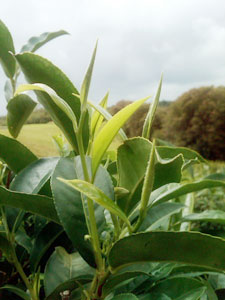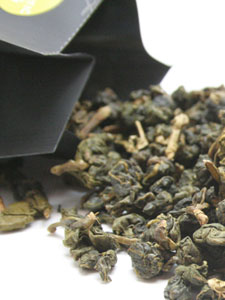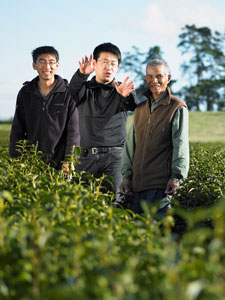Developments within the world of Oolong




Who doesn't love oolong tea? It's probably the best thing to come out of China next to paper. Whether you're a fan of the light green and floral oolongs or the dark and long roasted variety, you know that nothing beats a cup of good oolong tea. Can life get any better? Perhaps! The Heavens have opened up and the Jade Emperor, Lord of Tea, has smiled down upon us. There are changes a-brew-ing. Very exciting changes.
Traditionally, oolong tea has always been grown in China and, more recently, Taiwan. It is from China's Fujian province that we have the flowery Ti Kuan Yin as well as the dark varieties, which grow in the rocky Wuyi Mountains. From Taiwan we have the famous Ali Shan, Li Shan, and Pouchong oolongs, among others. Now there is more competition joining, threatening China's monopoly in the Oolong market. Bad news for China and Taiwan, good news for us oolong lovers.
Moonrise Tea Garden and Zealong are companies that have started growing tea in rather untraditional places. Probably the hardest thing to do, next to catching a fly with your fingertips, is to take a plant that is native to a certain region and introduce it to a totally different area. Even the slightest environmental variance could offset the fragile balance necessary for plants to grow properly, especially growing tea which requires extreme precision for maximal taste value. Somehow these companies did it.
Moonrise is an up and coming Hawaiian tea company that was started by Sherri Miller in 2006. She told us that the learning curve was very steep in the beginning. Hawaii never had a tea growing tradition, so there was a lack of both plant material and experts on cultivation. Luckily, we live in a global society now so Sherri was able to bring in experts from China, Taiwan, and Japan to help get things rolling. The experts all told her that Hawaii has perfect conditions for growing tea. The warm tropical climate of Hawaii, combined with volcanic activity and exposure to the salty sea, has made Hawaiian soil very good for growing certain crops. It seems that Camellia sinensis, the tea plant, may just be one of them.
Moonrise's tea fields are located on the slopes of Mauna Kea, a dormant volcano, in a rainforest environment 1,360 above sea level. Since the fields are in the rainforest, irrigating the soil is not necessary. Sherri told us that she uses organic, bio-dynamic, and natural growing techniques with the goal of not needing outside supplementation of fertilizer and feed. The plant material she uses has come from all the best places: China, Japan, Taiwan, and Darjeeling. The Hawaiian teas coming out of Moonrise are the epitome of small batch. They are hand-picked and processed by Sherri herself, and each lot is typically limited to a kilogram or so of finished leaf.
Right now, Moonrise is in an experimentation phase to see which varieties work best in the Hawaiian climate. Already, they offer 7 varieties of Hawaiian grown tea including white, green, oolong and black. The oolong, called Kaiwiki Oolong, is a favorite of Sherri's. She told us: "Processing oolong is tricky and not done to a specific recipe. Temperature, humidity, and the condition of the leaves are all factors. We smell and taste and feel our way through. Processing oolong on such a small scale is more art than science. Of all my interactions with tea, even more than drinking, I enjoy processing oolong the most."
All of the Hawaiian grown varieties grown by Moonrise have a unique signature, a Hawaiian note, that gives them a slightly different taste than more traditional kinds. The fact that it's grown in totally different soil with a different climate and atmosphere seems to make a huge difference. As difficult as it was to begin growing in Hawaii, there is a definite plus. Moonrise is able to harvest every month since the weather variance is minimal. Sherri told us, "We are literally growing the tea as fast as we can. But there is a lesson of patience with tea. Tea only grows as fast as tea grows." Perhaps the most difficult hurdle was adapting to the soil and environment, but now Moonrise is past the difficulties and experiencing very successful growth.
Zealong's Vincent Chen had similar luck with growing tea in New Zealand. Though initially there were problems such as getting past difficult government provisions, he eventually found that tea plants grow very well in the New Zealand climate. New Zealand has very tough restrictions on the import of live plants. Initially, Vincent imported 1,500 tea cuttings from Taiwan. For 10 months, the plants had to be kept in a MAF (Ministry of Agriculture) quarantine. Only 130 tea trees survived. It was from these trees that Vincent grew his tea garden, quite successfully in fact.
The best thing about New Zealand's environment is that it lacks many of the pests, diseases, and parasites that often plague tea plants in Asia. Vincent, along with some help from Taiwanese tea masters, has had success growing Camellia plants in New Zealand's environment. Zealong's 120 acre garden is in Gordonton, which is 1 kilometer from the Waikato river and one hour south of Auckland. The weather is mild, with plenty of sunshine and humid air. As evidenced by the green fields typical of a New Zealand landscape, they get plenty of rainfall. These are perfect conditions for growing tea and, as Vincent told us, "They grew."
Unfortunately there is much more to this business than just growing tea. Costs are much higher for labor and supplies compared to Taiwan and China, and Zealong chooses to pursue a very high standard of organic growing and processing. This makes Zealong's prices very steep compared to Chinese and Taiwanese options. According to Vincent, Zealong's tea is of much higher quality than traditional tea, thus justifying the steeper price. "New Zealand's air, sun, soil, and water produce leaves that are thicker and greener, giving our tea a more durable flavour, and more re-infusions. And the aroma is said to be fresher, more floral, and longer lasting." In essence, the promise of a purer and fresher taste, a better oolong.
Moonrise suffers a similar fate. Labor is not cheap in Hawaii and they also choose a very organic method of cultivation. Both Moonrise and Zealong have told us that even though their prices are higher, they have been met with a great reception not only locally but worldwide as well. Both companies were present at this year's World Tea Expo in Las Vegas, and Adagio's very own Charles Cain sampled both and was thoroughly impressed by both the exceptional quality of the leaves and the rich aroma and taste.
Whether or not you're interested in trying untraditional oolongs, you have to be excited at the prospect of something special. Without a doubt, these teas will taste slightly different. They will have their own character, their own style. Unquestionably, these teas will cost more than what you're used to paying, but perhaps it is a worthwhile investment. Remember: you're not just paying for a different tea. You're paying for the possibility of an East meets West interaction which could change the world of tea. Remember what cars were like before the Japanese made them infinitely better? Perhaps it is the West's turn to revolutionize an industry. This may just be the beginning of something beautiful.
